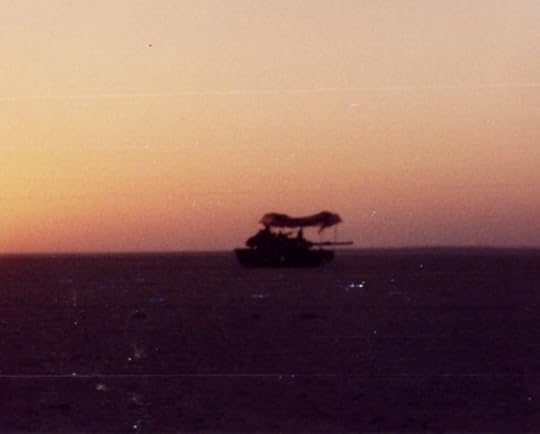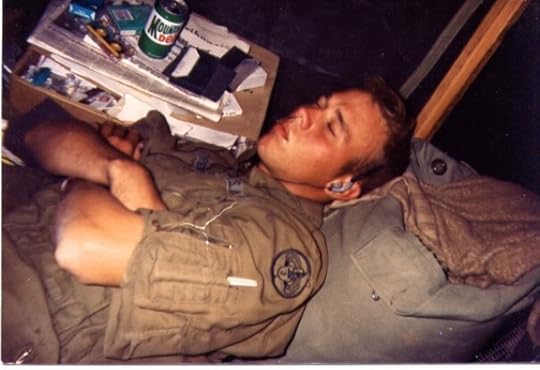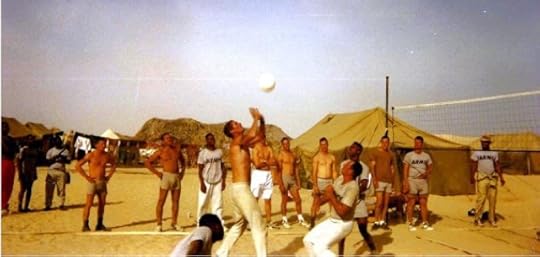An Aspis Aloft: my recollections of Desert Shield
(Continued from: The Path to the Shield (Part 2))
After chugging our water, and claiming our personal bags & equipment from the belly of the 747 contracted to deliver us unto the Sandbox, we mounted transport trucks (most of them, of the Deuce & a Half variety), and moved into what I believe was a warehouse. We were in the port of Jubail, issued a cot and told where to set up to sleep. Our platoon sergeant, a little whip of a SFC (Sergeant First Class) with a drawl and a penchant for fast cars, set up a platoon plan for the storage of personal gear, and initiated a sleep plan for the platoon as soon as we hit the floor of the building. Tank crews set up cots in a group, with the entire platoon in one area near to each other. We stored our personal gear as per sergeant Young's plan, and set about implementing the sleep rotation.
Ultimately, we spent just three days in the port; on the second day, the RO-RO (Roll-On Roll-Off) ship with our equipment on it docked nearby. We offloaded our equipment into a makeshift motor pool. First order of business was to check over the tanks, to make sure that all the parts & tools were present and functional, and then start them up to make sure they were in running order.
As a tanker, I can tell you there is little as soothing, as awe-inspiring, as nearly orgiastic as the dulcet sounds of an entire squadron of M1A1 tanks turning over their turbine engines. The whine and whistle of the final phase of startup, a rising crescendo of whistle and screech, culminating in a throaty whoosh of rushing exhaust, is as orgasmic a sound as exists, to a tank crewman, and to hear all 42 of the Squadron's tanks start up in quick succession was the first real sign of the awesome power our military would flex in the weeks and months to come. Next, we ran all the self-tests and did our Preventative Maintenance Checks and Services—PMCS, if you like—and made sure to store as many of our things as we could, on the tank. We were working so hard, we hardly noticed how hot it was: 110° F+ on the concrete pad, despite being only a few meters from the Persian Gulf waters. I didn't notice until I felt something weird and sticky on my chest: my tee-shirt; at that time, we were mostly in our "chocolate chip" desert BDUs. While working on the tanks we were usually permitted to remove our BDU top and work in our tee-shirts. It was plastered to my chest, and white crusty edges had formed in any place where my sweat had evaporated. I looked at the temperature gauge for the ammo compartment: 130° F. No wonder I was sweating so profusely: it was hotter than Hades. That brought back to the forefront of my mind the warning of a couple of days before to drink water every chance we got: we lose track of how hard we're working, and how fast we're losing it!
Lunch time came, we ate, and continued to work. Despite the temperature concerns, the Regiment issued a nearly complete service load of ammo for all our weapon systems. This included the 120mm Main Gun, all three machine guns, as well as personal weapons and sidearms. As a result, armed guards began to patrol the motor pool area.
We spent one more night in the warehouse. The next day, we proceeded to load up the tanks with most of our personal equipment and gear, save our rucksacks & sidearms. At just about noon we started to load our tanks onto Heavy Equipment Transport (HET) trucks, one tank per truck, for a road march to our offload point in the middle of BFE (well, maybe BFSA, since we were in Saudi Arabia). We traversed the Tap Line road NW for several hours, then sometime near about 21:00 or so we stopped, off-loaded all of the HETs, and assembled our vehicles. When we reported ready, our Troop Commander led us out into the featureless (and extremely dark) desert. We drove in a column formation for several more hours, and finally arrived at our designated Assembly Area. After setting perimeter security, we implemented a guard & sleep plan, and were able to bed down for the few remaining hours until sun-up.
To this day, the first night I spent in Saudi Arabia out in the deep desert is still one of my most cherished memories. Disregarding for a moment the reason for my presence—and the danger that would unfold there—it was as peaceful and serene a night as I've ever experienced, before or since. With the tanks all shut down (at least their engines), and no other vehicles operating, the only noise was the occasional shuffling of feet or clanking of metal objects, as someone closed a vehicle hatch or dropped a tool. Wartime night operations call for strict light discipline, and tank crews such as you find in the 3d ACR are quite adept at it. Because of that, not only were there no city lights but also no local ones to interfere with my vision of the bejeweled heavens above: a veritable blanket of black with our own, personal, thousand points of light gleaming down. I recall being on the front deck of my tank, with my driver Errol and my buddy Rob, just admiring the stark contrast: utter, universal beauty above, and sheer horror around, until we finally gave in and settled into sleep.
 C-22 off in the distance during Exercise Imminent Thunder, somewhere in the middle of the Saudi desertWe didn't get much sleep; the arrival at the AA was approximately 02:30 and sunup in the desert there was around 05:30 or so. The squadron command staff gathered, selected a location for our Base Camp, and we executed a short movement to what would become Base Camp Bessey (named after one of the Regiment's earliest Medal of Honor winners, in 1877), and our home for the next couple of months.
C-22 off in the distance during Exercise Imminent Thunder, somewhere in the middle of the Saudi desertWe didn't get much sleep; the arrival at the AA was approximately 02:30 and sunup in the desert there was around 05:30 or so. The squadron command staff gathered, selected a location for our Base Camp, and we executed a short movement to what would become Base Camp Bessey (named after one of the Regiment's earliest Medal of Honor winners, in 1877), and our home for the next couple of months.
Once in Base Camp Bessey, we approximated a normal routine: PT in the very early morning, breakfast, tank maintenance or training, lunch, more tank maintenance or training, inspections, dinner, and nighttime ablutions. Speaking of ... showers. And body cleansing. At first, it was the so-called "whore's bath": soap, water in an empty ammo can, and a washcloth. Rub mostly in the stinky parts of the body, followed by a rinse. Then, the engineers constructed a reasonable facsimile of a shower facility. There were three of them (as I recall); two 4-person stands for men and a single 2-person for women. I don't recall there being any women in the Squadron; there might have been a couple in the HQ element, but I don't think so. There were MPs and attached logistic and supply units, which may have necessitated the separate facilities. In any event, the facilities were great, but the water ... well, let's just recall water has a high specific heat. When it got really pretty darned cold, like at night, the water in the showers would get just as cold so everybody took a cold shower. On the plus side, knowing the shower water would be cold meant nobody lingered: everybody got exactly as wet as needed, soaped & shampooed up, then got exactly as rinsed as needed, and nobody took too long. Eventually, the engineers who built the showers figured out a way to get an immersion heater in the water supply, and that meant we could take warm showers.
At first, the tents we received for the base camp were donations from local Bedouin tribes, and were just big enough for a single tank crew. After about a month or so in Base Camp Bessey, Squadron issued larger tents (the famous GP Medium!). I seem to recall it was both 1st (Scout) platoon, and 2nd (Tank) platoon who lived in our tent.
 The author, ambushed by a camera while sleeping in the luxurious new GP Medium tentsIt wasn't all training. Soldiers, like anyone, need some kind of down time occasionally to maintain their sanity. We had sports events; volleyball and flag football were both favorites.
The author, ambushed by a camera while sleeping in the luxurious new GP Medium tentsIt wasn't all training. Soldiers, like anyone, need some kind of down time occasionally to maintain their sanity. We had sports events; volleyball and flag football were both favorites.
 That would be SSG Miller, 2nd (Tank) Platoon, C-1/3 ACR, setting a dig. Naturally, 2nd Platoon dominated.We also did specific training exercises; during November, we were part of Exercise Imminent Thunder, and practiced several action drills & squadron/troop roles in the offense and defense: movement to contact, deliberate attack, hasty attack, hasty defense with counter-attack, and so forth. After Imminent Thunder, our regiment received a warning that we had new equipment coming. Newer M1A1HA tanks would replace our older M1A1s. Each tank platoon in the regiment was tasked to send a small detail to head out to King Abdulaziz port in Dammam to help offload them when they arrived. We spent Christmas and New Year's both in port, offloaded the tanks, and delivered them to the DOD civilians who were responsible for initial testing and final painting (desert sand, this time). After we finished our detail we were bussed back to our unit, which had been moved from the base camp into a more tactical assembly area. Here, they did initial weapons zero and gunnery with the new tanks.
That would be SSG Miller, 2nd (Tank) Platoon, C-1/3 ACR, setting a dig. Naturally, 2nd Platoon dominated.We also did specific training exercises; during November, we were part of Exercise Imminent Thunder, and practiced several action drills & squadron/troop roles in the offense and defense: movement to contact, deliberate attack, hasty attack, hasty defense with counter-attack, and so forth. After Imminent Thunder, our regiment received a warning that we had new equipment coming. Newer M1A1HA tanks would replace our older M1A1s. Each tank platoon in the regiment was tasked to send a small detail to head out to King Abdulaziz port in Dammam to help offload them when they arrived. We spent Christmas and New Year's both in port, offloaded the tanks, and delivered them to the DOD civilians who were responsible for initial testing and final painting (desert sand, this time). After we finished our detail we were bussed back to our unit, which had been moved from the base camp into a more tactical assembly area. Here, they did initial weapons zero and gunnery with the new tanks.
Finally, after just over three-and-a-half months, we moved out to a new assembly area. While there, about to take responsibility for a guard shift, I heard the news over the radio: war had begun.
(Continued: The Storm Starts)
After chugging our water, and claiming our personal bags & equipment from the belly of the 747 contracted to deliver us unto the Sandbox, we mounted transport trucks (most of them, of the Deuce & a Half variety), and moved into what I believe was a warehouse. We were in the port of Jubail, issued a cot and told where to set up to sleep. Our platoon sergeant, a little whip of a SFC (Sergeant First Class) with a drawl and a penchant for fast cars, set up a platoon plan for the storage of personal gear, and initiated a sleep plan for the platoon as soon as we hit the floor of the building. Tank crews set up cots in a group, with the entire platoon in one area near to each other. We stored our personal gear as per sergeant Young's plan, and set about implementing the sleep rotation.
Ultimately, we spent just three days in the port; on the second day, the RO-RO (Roll-On Roll-Off) ship with our equipment on it docked nearby. We offloaded our equipment into a makeshift motor pool. First order of business was to check over the tanks, to make sure that all the parts & tools were present and functional, and then start them up to make sure they were in running order.
As a tanker, I can tell you there is little as soothing, as awe-inspiring, as nearly orgiastic as the dulcet sounds of an entire squadron of M1A1 tanks turning over their turbine engines. The whine and whistle of the final phase of startup, a rising crescendo of whistle and screech, culminating in a throaty whoosh of rushing exhaust, is as orgasmic a sound as exists, to a tank crewman, and to hear all 42 of the Squadron's tanks start up in quick succession was the first real sign of the awesome power our military would flex in the weeks and months to come. Next, we ran all the self-tests and did our Preventative Maintenance Checks and Services—PMCS, if you like—and made sure to store as many of our things as we could, on the tank. We were working so hard, we hardly noticed how hot it was: 110° F+ on the concrete pad, despite being only a few meters from the Persian Gulf waters. I didn't notice until I felt something weird and sticky on my chest: my tee-shirt; at that time, we were mostly in our "chocolate chip" desert BDUs. While working on the tanks we were usually permitted to remove our BDU top and work in our tee-shirts. It was plastered to my chest, and white crusty edges had formed in any place where my sweat had evaporated. I looked at the temperature gauge for the ammo compartment: 130° F. No wonder I was sweating so profusely: it was hotter than Hades. That brought back to the forefront of my mind the warning of a couple of days before to drink water every chance we got: we lose track of how hard we're working, and how fast we're losing it!
Lunch time came, we ate, and continued to work. Despite the temperature concerns, the Regiment issued a nearly complete service load of ammo for all our weapon systems. This included the 120mm Main Gun, all three machine guns, as well as personal weapons and sidearms. As a result, armed guards began to patrol the motor pool area.
We spent one more night in the warehouse. The next day, we proceeded to load up the tanks with most of our personal equipment and gear, save our rucksacks & sidearms. At just about noon we started to load our tanks onto Heavy Equipment Transport (HET) trucks, one tank per truck, for a road march to our offload point in the middle of BFE (well, maybe BFSA, since we were in Saudi Arabia). We traversed the Tap Line road NW for several hours, then sometime near about 21:00 or so we stopped, off-loaded all of the HETs, and assembled our vehicles. When we reported ready, our Troop Commander led us out into the featureless (and extremely dark) desert. We drove in a column formation for several more hours, and finally arrived at our designated Assembly Area. After setting perimeter security, we implemented a guard & sleep plan, and were able to bed down for the few remaining hours until sun-up.
To this day, the first night I spent in Saudi Arabia out in the deep desert is still one of my most cherished memories. Disregarding for a moment the reason for my presence—and the danger that would unfold there—it was as peaceful and serene a night as I've ever experienced, before or since. With the tanks all shut down (at least their engines), and no other vehicles operating, the only noise was the occasional shuffling of feet or clanking of metal objects, as someone closed a vehicle hatch or dropped a tool. Wartime night operations call for strict light discipline, and tank crews such as you find in the 3d ACR are quite adept at it. Because of that, not only were there no city lights but also no local ones to interfere with my vision of the bejeweled heavens above: a veritable blanket of black with our own, personal, thousand points of light gleaming down. I recall being on the front deck of my tank, with my driver Errol and my buddy Rob, just admiring the stark contrast: utter, universal beauty above, and sheer horror around, until we finally gave in and settled into sleep.
 C-22 off in the distance during Exercise Imminent Thunder, somewhere in the middle of the Saudi desertWe didn't get much sleep; the arrival at the AA was approximately 02:30 and sunup in the desert there was around 05:30 or so. The squadron command staff gathered, selected a location for our Base Camp, and we executed a short movement to what would become Base Camp Bessey (named after one of the Regiment's earliest Medal of Honor winners, in 1877), and our home for the next couple of months.
C-22 off in the distance during Exercise Imminent Thunder, somewhere in the middle of the Saudi desertWe didn't get much sleep; the arrival at the AA was approximately 02:30 and sunup in the desert there was around 05:30 or so. The squadron command staff gathered, selected a location for our Base Camp, and we executed a short movement to what would become Base Camp Bessey (named after one of the Regiment's earliest Medal of Honor winners, in 1877), and our home for the next couple of months.Once in Base Camp Bessey, we approximated a normal routine: PT in the very early morning, breakfast, tank maintenance or training, lunch, more tank maintenance or training, inspections, dinner, and nighttime ablutions. Speaking of ... showers. And body cleansing. At first, it was the so-called "whore's bath": soap, water in an empty ammo can, and a washcloth. Rub mostly in the stinky parts of the body, followed by a rinse. Then, the engineers constructed a reasonable facsimile of a shower facility. There were three of them (as I recall); two 4-person stands for men and a single 2-person for women. I don't recall there being any women in the Squadron; there might have been a couple in the HQ element, but I don't think so. There were MPs and attached logistic and supply units, which may have necessitated the separate facilities. In any event, the facilities were great, but the water ... well, let's just recall water has a high specific heat. When it got really pretty darned cold, like at night, the water in the showers would get just as cold so everybody took a cold shower. On the plus side, knowing the shower water would be cold meant nobody lingered: everybody got exactly as wet as needed, soaped & shampooed up, then got exactly as rinsed as needed, and nobody took too long. Eventually, the engineers who built the showers figured out a way to get an immersion heater in the water supply, and that meant we could take warm showers.
At first, the tents we received for the base camp were donations from local Bedouin tribes, and were just big enough for a single tank crew. After about a month or so in Base Camp Bessey, Squadron issued larger tents (the famous GP Medium!). I seem to recall it was both 1st (Scout) platoon, and 2nd (Tank) platoon who lived in our tent.
 The author, ambushed by a camera while sleeping in the luxurious new GP Medium tentsIt wasn't all training. Soldiers, like anyone, need some kind of down time occasionally to maintain their sanity. We had sports events; volleyball and flag football were both favorites.
The author, ambushed by a camera while sleeping in the luxurious new GP Medium tentsIt wasn't all training. Soldiers, like anyone, need some kind of down time occasionally to maintain their sanity. We had sports events; volleyball and flag football were both favorites. That would be SSG Miller, 2nd (Tank) Platoon, C-1/3 ACR, setting a dig. Naturally, 2nd Platoon dominated.We also did specific training exercises; during November, we were part of Exercise Imminent Thunder, and practiced several action drills & squadron/troop roles in the offense and defense: movement to contact, deliberate attack, hasty attack, hasty defense with counter-attack, and so forth. After Imminent Thunder, our regiment received a warning that we had new equipment coming. Newer M1A1HA tanks would replace our older M1A1s. Each tank platoon in the regiment was tasked to send a small detail to head out to King Abdulaziz port in Dammam to help offload them when they arrived. We spent Christmas and New Year's both in port, offloaded the tanks, and delivered them to the DOD civilians who were responsible for initial testing and final painting (desert sand, this time). After we finished our detail we were bussed back to our unit, which had been moved from the base camp into a more tactical assembly area. Here, they did initial weapons zero and gunnery with the new tanks.
That would be SSG Miller, 2nd (Tank) Platoon, C-1/3 ACR, setting a dig. Naturally, 2nd Platoon dominated.We also did specific training exercises; during November, we were part of Exercise Imminent Thunder, and practiced several action drills & squadron/troop roles in the offense and defense: movement to contact, deliberate attack, hasty attack, hasty defense with counter-attack, and so forth. After Imminent Thunder, our regiment received a warning that we had new equipment coming. Newer M1A1HA tanks would replace our older M1A1s. Each tank platoon in the regiment was tasked to send a small detail to head out to King Abdulaziz port in Dammam to help offload them when they arrived. We spent Christmas and New Year's both in port, offloaded the tanks, and delivered them to the DOD civilians who were responsible for initial testing and final painting (desert sand, this time). After we finished our detail we were bussed back to our unit, which had been moved from the base camp into a more tactical assembly area. Here, they did initial weapons zero and gunnery with the new tanks.Finally, after just over three-and-a-half months, we moved out to a new assembly area. While there, about to take responsibility for a guard shift, I heard the news over the radio: war had begun.
(Continued: The Storm Starts)
Published on September 07, 2015 11:12
No comments have been added yet.



